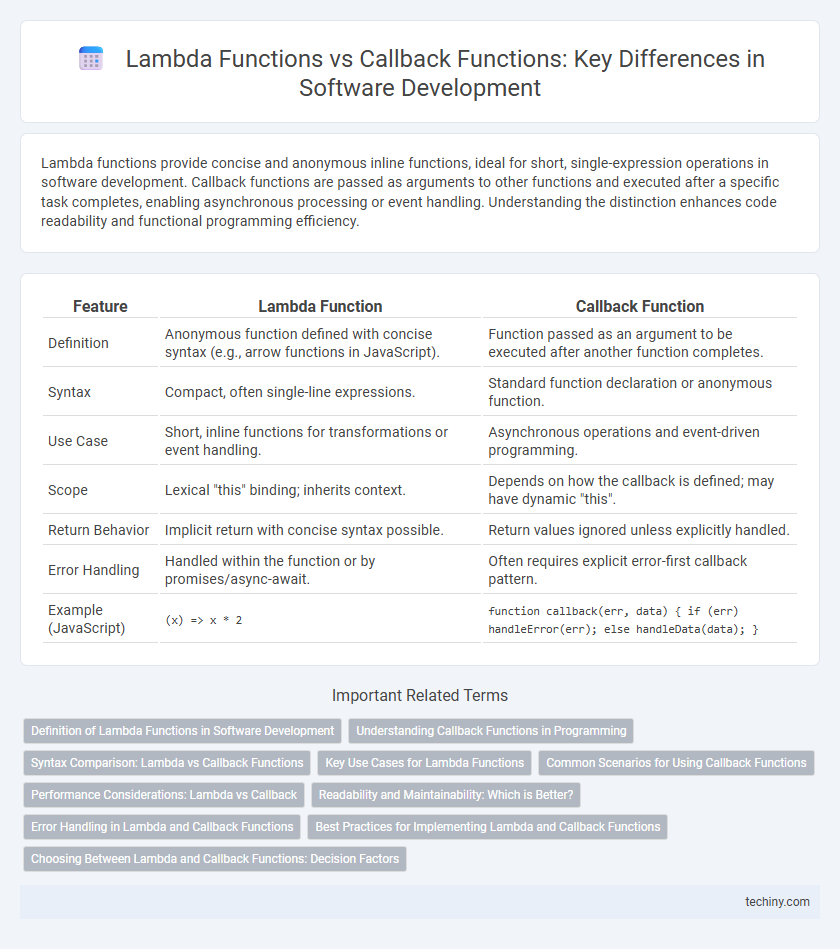Lambda functions provide concise and anonymous inline functions, ideal for short, single-expression operations in software development. Callback functions are passed as arguments to other functions and executed after a specific task completes, enabling asynchronous processing or event handling. Understanding the distinction enhances code readability and functional programming efficiency.
Table of Comparison
| Feature | Lambda Function | Callback Function |
|---|---|---|
| Definition | Anonymous function defined with concise syntax (e.g., arrow functions in JavaScript). | Function passed as an argument to be executed after another function completes. |
| Syntax | Compact, often single-line expressions. | Standard function declaration or anonymous function. |
| Use Case | Short, inline functions for transformations or event handling. | Asynchronous operations and event-driven programming. |
| Scope | Lexical "this" binding; inherits context. | Depends on how the callback is defined; may have dynamic "this". |
| Return Behavior | Implicit return with concise syntax possible. | Return values ignored unless explicitly handled. |
| Error Handling | Handled within the function or by promises/async-await. | Often requires explicit error-first callback pattern. |
| Example (JavaScript) | (x) => x * 2 |
function callback(err, data) { if (err) handleError(err); else handleData(data); } |
Definition of Lambda Functions in Software Development
Lambda functions in software development are anonymous, inline functions defined with a concise syntax, primarily used for short, single-expression operations. They enable the creation of function objects without explicitly naming a function, facilitating higher-order programming and functional paradigms. Compared to callback functions, lambda functions often serve as inline callbacks that increase code readability and reduce boilerplate in languages like Python, JavaScript, and Java.
Understanding Callback Functions in Programming
Callback functions in programming are crucial for handling asynchronous operations, allowing a function to be passed as an argument and executed after a task completes. Unlike lambda functions, which are anonymous and primarily used for inline expressions, callbacks manage control flow in event-driven and asynchronous environments. Understanding callback functions enhances the ability to write non-blocking code, improve responsiveness, and maintain clean, modular software design.
Syntax Comparison: Lambda vs Callback Functions
Lambda functions in software development offer concise, inline syntax using the "lambda" keyword, typically defining anonymous functions with an implicit return. Callback functions require explicit function declarations or expressions and are passed as arguments to other functions to handle asynchronous operations or events. Lambda syntax streamlines code by reducing boilerplate, while callbacks provide clearer naming and structure, especially in complex scenarios.
Key Use Cases for Lambda Functions
Lambda functions excel in scenarios requiring concise, inline function definitions for event-driven programming, such as in AWS Lambda for scalable cloud computing. They are ideal for real-time data processing tasks where minimal latency and stateless execution are critical. Lambda functions also streamline functional programming techniques by enabling quick, anonymous operations within higher-order functions like map, filter, and reduce.
Common Scenarios for Using Callback Functions
Callback functions are commonly used in asynchronous programming to handle tasks such as API responses, event handling, and timer operations. They enable non-blocking code execution by passing functions as arguments that are invoked once an operation completes, improving application responsiveness. Examples include managing data fetching in JavaScript with XMLHttpRequest or handling user input events in graphical user interfaces.
Performance Considerations: Lambda vs Callback
Lambda functions offer concise syntax and can lead to improved readability, but their impact on performance is minimal compared to traditional callback functions. Callbacks can sometimes provide better optimization opportunities since they avoid the overhead of creating new function instances repeatedly, especially in tight loops or high-frequency asynchronous operations. Benchmarking specific use cases is essential because performance differences between lambda and callback functions often depend on the JavaScript engine and runtime environment.
Readability and Maintainability: Which is Better?
Lambda functions enhance readability by offering concise, inline expressions that reduce boilerplate code, making them ideal for simple operations. Callback functions provide greater maintainability through named, reusable blocks of code that clarify asynchronous workflows and improve debugging. Selecting between the two depends on the complexity of the task and the need for clear structure versus succinctness in codebases.
Error Handling in Lambda and Callback Functions
Lambda functions streamline error handling in software development by enabling concise inline expressions, but they require explicit mechanisms like try-except blocks to catch exceptions. Callback functions allow more comprehensive error management through defined parameters, often using an error-first pattern (error, result) to handle failures gracefully. Effective error handling in both requires careful design to prevent unhandled exceptions and maintain code reliability.
Best Practices for Implementing Lambda and Callback Functions
Best practices for implementing Lambda and Callback functions include ensuring clear naming conventions and minimizing side effects to enhance code readability and maintainability. Lambda functions should be concise and focused on a single task, leveraging their stateless nature for functional programming patterns. Callback functions must handle asynchronous operations with proper error handling and avoid deeply nested structures to prevent callback hell.
Choosing Between Lambda and Callback Functions: Decision Factors
Choosing between lambda functions and callback functions hinges on readability, scope, and use-case complexity. Lambda functions, characterized by concise, inline expressions, enhance code brevity and are ideal for simple, short-lived operations, whereas callback functions, often named and defined separately, provide better clarity and reusability in asynchronous workflows. Decision factors include the need for clarity in debugging, the importance of lexical scoping for variables, and whether the function requires access to the enclosing context or handles complex logic flows.
Lambda Function vs Callback Function Infographic

 techiny.com
techiny.com